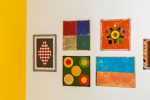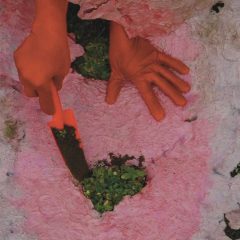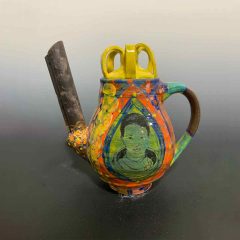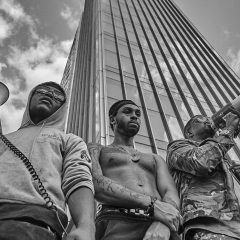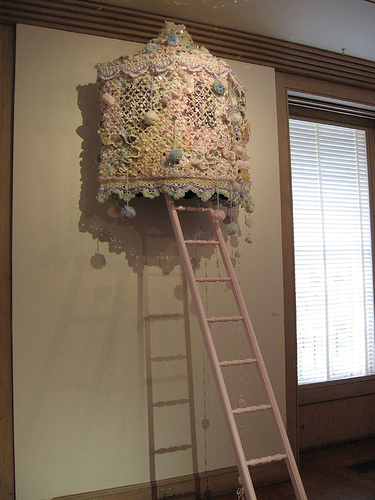
Ambush, by Kimberley Hart, 2005, fabric, yarn, pailettes, sequins, beads, upholstery tacks, ladder, salt. This is a female version of a tree house, all crocheted. Even the ladder is pink. There are grill-covered windows on this that remind me of grills behind which Muslim women invisibly peer out onto the street.
In the left corner is art, and in the right is craft, but at Abington Art Center right now, it’s tough to tell the two apart–and by mixing it up, the exhibit–The HandMaking–asks all kinds of interesting questions about both and about value and about women’s work and men’s work and all of those juicy questions that we still haven’t been able to quite answer. But that’s what makes it all so interesting.
And that is what made a panel discussion at Abington Saturday all the more interesting. The panel included artists Polly Apfelbaum, Suzie Brandt, Annette Monnier and Lee Stoetzel, all of them in the exhibit of work by 21 artists. Moderator Amy Lipton kept the discussion moving with the hard questions. Lipton, who is curator at Abington, curated the exhibit with Joele Cuyler, creative director at Modern Painters magazine, and more to the point, former creative director at Martha Stewart Living Magazine.
Lipton’s first question was whether there was a difference between craft and high art, and no one was willing to draw a firm distinction.
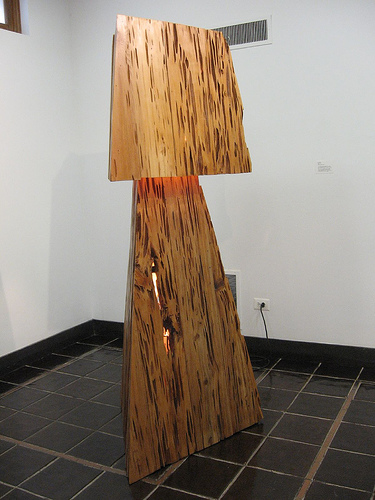
Pecky Lamp, by Lee Stoetzel, 2000, wood, light fixtures. This riff on an Arts and Crafts movement lamp pumped up to gigantic scale and using cedar distressed by a virus brings into question everything that arts and crafts and the Arts and Crafts movement represent.
When Stoetzel got a job at a gallery that showed Richard Artschwager, he said something clicked. “If you could hang furniture on the wall…” you could do whatever you wanted, hang whatever on the wall. “I didn’t want to make paintings anymore.” Stoetzel has a solo exhibit opening April 26 at Mixed Greens.
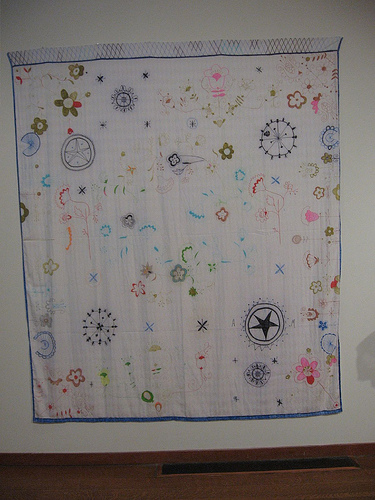
Tapestry/sheet (folk), by Annette Monnier, 2006, fabric marker on ‘Martha Stewart Collection’ full-sized sheet. Monnier is true to her word and uses craft materials at the same time that her work discusses art, decor and value.
Monnier, gallerist at the new Copy, and also a trend spotter for Gyro Worldwide Advertising and more, was less theoretical but came to the same conclusion–“I don’t see a difference. I’ve never used artist’s materials. I always used markers or whatever was handy. WalMart was close to my house and had what I needed. I use what’s around.” Indeed markers are what Monnier used on her Tapestry/sheet (folk), 2006, fabric marker on ‘Martha Stewart Collection’ full-sized sheet, one of her pieces in the exhibit.
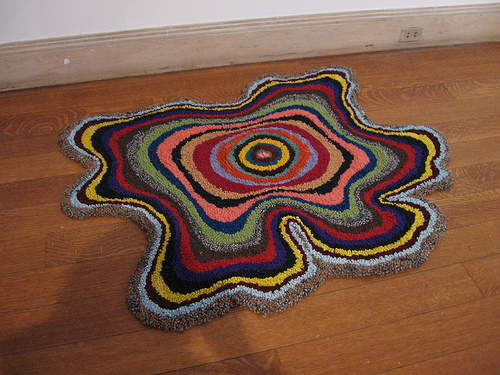
Belair Rd, by Suzie Brandt, 2006, hand hooked wool rug. Brandt’s rug served as a sort of doily atop a real tree stump on Belair Rd. The installation at Abington included a picture postcard of the rug atop the stump. Among the issues the work raises is whether the tree is more beautiful or more domesticated with its colored stripes. It also marks a place with the human touch and reminds us to notice the remainder of what was once a huge tree.
Brandt, who teaches fiber at MICA, related her interest in fiber art to her sewing experience as a child. And Apfelbaum (I’m linking here to her solo show at the ICA in 2003), told about moving to New York in 1978, when artists were using different kinds of materials. When a student at Tyler, Apfelbaum started in printmaking, but that didn’t last. “It was for me reinventing craft.”
Lipton cited a number of recent and current art exhibits with craft themes–like Radical Lace and Subversive Knitting and Socialcraft–and wondered why this was happening. She asked whether the return to handmade was a reaction to the hands-off digital world.
While Stoetzel agreed, Monnier said she had other motives. “I have a do-it-yourself ethos. I have nothing against technology. I hope it’s not a backlash”
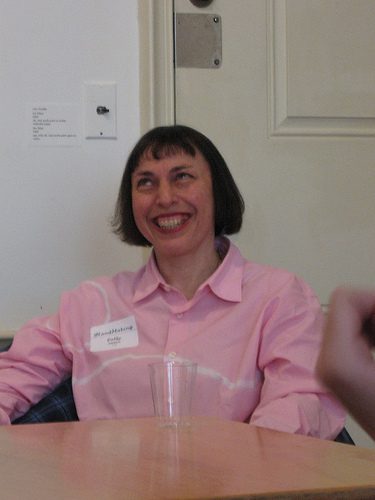
Ironically, I came home without a photo of Polly Apfelbaum’s piece. But here’s a picture of her during the panel discussion. She looks like my 2nd grade teacher, Mrs. Goodman, who I really loved.
Apfelbaum also thought it wasn’t a backlash. “It’s like painting. It’s always there, and whether people are paying attention…For me there is a tradition I like. I think of Amish quilts.”
Brandt redefined made by hand: “I was trying to learn key commands for Illustrator. Now that’s handwork.” That earned her a laugh.
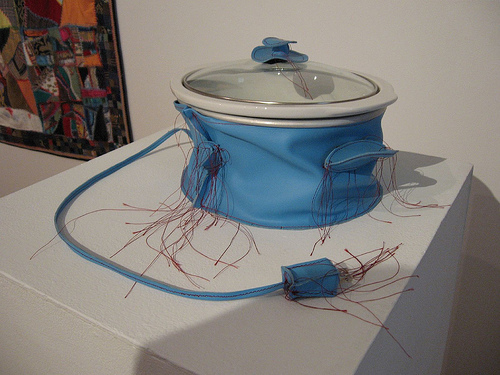
Margarita Cabrera, Slow Cooker, 2003, vinyl, thread, metal, electric wiring, ceramic plate; Cabrera, who is from El Paso, sews art about the work women do and the value placed on it. Her other piece in the show is a cleaning kit made totally of black pleather and thread. She’s bringing Claes Oldenberg down to homey scale and adding all kinds of not-so-lighthearted content.
In a discussion that began with Andrea Zittel, represented in the exhibit by a felt dress that she made from scratch, including making the fiber, Stoetzel mentioned how Margarita Cabrera (also in the exhibit) made her stitches very evident. “The stitching proves that it’s handmade.” Lipton added that Cabrera also stitches together “giant Hummers and cactus plants,” which led her to ask about function in art.
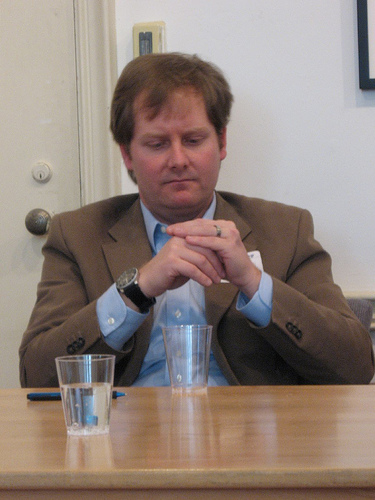
Lee Stoetzel listening during the panel discussion.
Brandt joked, “It’s not art if your body touches it.” Apfelbaum claimed her work was functional–but temporal, and got a laugh, too. And then Sue Spaid, who wrote the brochure essay for the exhibit, interjected from the audience with the idea that art has a function–to engender thought.
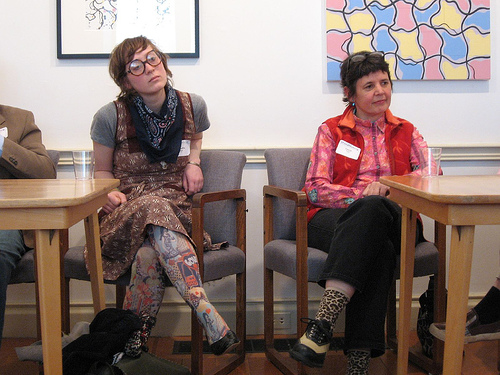
Here’s a picture of Monnier and Brandt. I liked that their poses mirrored one another. And who could resist Annette’s tights and Suzie’s socks?
Monnier, whose artificial floral arrangements also are in the exhibit, said it was art was like flowers, “something you’d put to decorate a room, so art is something functional.”
Apfelbaum enthusiastically jumped on the bandwagon and said she thinks of her work as still life. “Still life is important to me.” Then she said, “I’ve been connected to painting and sculpture. I’m privileged. I’m very happy to be in this place.” And she pointed to how Anni Albers’ weavings were designated craft and how fiber artist Sheila Hicks shows in craft shows. “I love that stuff.”
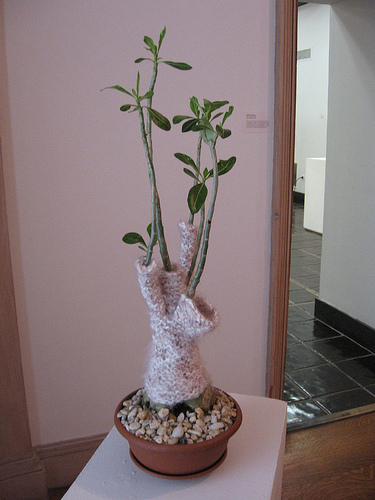
Elizabeth Demaray, Plant Sweater, 2007,plant, Shetland wool; This was the antithesis of a still life.
Spaid wondered what kind of reception The HandMaking would get if it were exhibited at Michael’s. “It’s layered with meaning in a way crafts is not layered with meaning.

Daina Taimina, We are the Same, 2005, cotton. In addition to reflecting calculations for hyperbolic planes, this also falls in the social commentary category; the orange and blue are reversed on the pair.
Lipton mentioned Daina Taimina’s crocheted piece, We Are The Same. Taimina, who is a math professor at Cornell, began using crochet to demonstrate hyperbolic planes–(don’t ask, but it has to do with numbers and space that is non-Euclidean. (The result, Spaid muttered sotto voce to me, looks like escarole). The art world jumped on it and absorbed it.
“The art world will take on anything that’s good,” said Monnier. So much for the crafts designation mattering.
I’m not sure who then related this story (Lipton? Spaid?) but the tale went that Ken Price refused to be in a show called Crafty until they changed its name to Homemade Champagne.
Monnier again piped up, “If the effect’s different enough, someone is going to want it. …I’m not skilled, so what you were saying about having to be really good at something, well I’m just screwed.”
This exhibit has so many wonderful pieces by so many great artists that I’m just going to list the others I haven’t yet named: Nancy Bauch, Francis Cape, Nick Cave, Jody Culkin, Jim Isermann, Maira Kalman, Larry Krone, Elizabeth Lundberg Morisette, Michael Manuel Barndt, Virgil Marti, Meridith McNeal, Christy Rupp, and Tucker Schwarz.
More images on my Flickr site.


